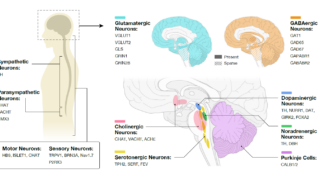Proteomic insights into extracellular vesicles in ALS for therapeutic potential of Ropinirole and biomarker discovery
ロピニロール塩酸塩の第Ⅰ/Ⅱa相医師主導治験(ROPALS試験)に参加した筋萎縮性側索硬化症(ALS)患者由来の血液ならびに脳脊髄液(CSF)に含まれる細胞外小胞(EVs)におけるタンパク質組成の経時的かつ網羅的定量を行い、体液由来EVsのタンパク質組成が孤発性ALS(SALS)患者において健常者と異なること、また、その変化が経時的なSALS病態進行においても同様に起こること、ROPI投与によってこの変化が抑制されることを見出しました。
加えて、人工多能性幹細胞(iPSC)由来アストロサイト(iPast)を用いた研究により、ROPIがIDPの1種であるD2R-CRYAB経路という神経炎症を抑制する経路を活性化している可能性が示唆されました。さらに、機械学習モデルを用いたバイオマーカー探索によって、予後予測ならびに診断において有用と推定されるタンパク質群をそれぞれ同定しました。
EVsは、ほとんどの細胞種から血液やCSFなどの体液中に分泌され、タンパク質や核酸などを内包していることから、細胞間の生体物質伝達に関わっているとされており、悪性腫瘍やSALSなどの神経変性疾患において疾患への寄与やバイオマーカーとしての有用性が推定されています。しかし、SALSにおける経時的かつ網羅的なEVタンパク質組成や、予後予測において有用なバイオマーカーはよく分かっていませんでした。また、ROPALS試験にて病態進行抑制効果が示唆されたROPIによるEVタンパク質組成変化は不明でした。今回、ROPALS試験のリバーストランスレーショナル研究(reverse translational research, rTR)として本研究を行い、経時的な患者由来体液を用いた網羅的なEVタンパク質組成を調べ、これらを明らかにしました。
以上の事柄について、『Inflammation and Regeneration』誌に報告しました(貢献内容:ヒト疾患iPS細胞モデルを用いたIDP関連治療作用メカニズムの同定とバイオマーカー開発)。

Abstract:
Background: Extracellular vesicles (EVs) hold the potential for elucidating the pathogenesis of amyotrophic lateral sclerosis (ALS) and serve as biomarkers. Notably, the comparative and longitudinal alterations in the protein profiles of EVs in serum (sEVs) and cerebrospinal fluid (CSF; cEVs) of sporadic ALS (SALS) patients remain uncharted. Ropinirole hydrochloride (ROPI; dopamine D2 receptor [D2R] agonist), a new anti-ALS drug candidate identified through induced pluripotent stem cell (iPSC)-based drug discovery, has been suggested to inhibit ALS disease progression in the Ropinirole Hydrochloride Remedy for Amyotrophic Lateral Sclerosis (ROPALS) trial, but its mechanism of action is not well understood. Therefore, we tried to reveal longitudinal changes with disease progression and the effects of ROPI on protein profiles of EVs.
Methods: We collected serum and CSF at fixed intervals from ten controls and from 20 SALS patients participating in the ROPALS trial. Comprehensive proteomic analysis of EVs, extracted from these samples, was conducted using liquid chromatography/mass spectrometer (LC/MS). Furthermore, we generated iPSC-derived astrocytes (iPasts) and performed RNA sequencing on astrocytes with or without ROPI treatment.
Results: The findings revealed notable disparities yet high congruity in sEVs and cEVs protein profiles concerning disease status, time and ROPI administration. In SALS, both sEVs and cEVs presented elevated levels of inflammation-related proteins but reduced levels associated with unfolded protein response (UPR). These results mirrored the longitudinal changes after disease onset and correlated with the revised ALS Functional Rating Scale (ALSFRS-R) at sampling time, suggesting a link to the onset and progression of SALS. ROPI appeared to counteract these changes, attenuating inflammation-related protein levels and boosting those tied to UPR in SALS, proposing an anti-ALS impact on EV protein profiles. Reverse translational research using iPasts indicated that these changes may partly reflect the DRD2-dependent neuroinflammatory inhibitory effects of ROPI. We have also identified biomarkers that predict diagnosis and disease progression by machine learning-driven biomarker search.
Conclusions: Despite the limited sample size, this study pioneers in reporting time-series proteomic alterations in serum and CSF EVs from SALS patients, offering comprehensive insights into SALS pathogenesis, ROPI-induced changes, and potential prognostic and diagnostic biomarkers.
Keywords: Amyotrophic lateral sclerosis (ALS); Astrocytes; Blood; Cerebrospinal fluid (CSF); Extracellular vesicle; Induced pluripotent stem cells (iPSCs); Motor neurons; Proteomics; Time-series.
Author: Kato C*, Ueda K*, Morimoto S*†, Takahashi S*, Nakamura S, Ozawa F, Ito D, Daté Y, Okada K, Kobayashi N, Nakahara J, Okano H†.
*contributed equally, †co-correspondence
Journal: Inflamm Regen. 2024 Jul 12;44(1):32. doi: 10.1186/s41232-024-00346-1.
投稿者プロフィール

- Project Associate Professor
-
Satoru Morimoto, M.D., Ph.D.
Keio University Regenerative Medicine Research Center (KRM)
Project associate professorResearch Gate Building TONOMACHI 2, 4B, 3-25-10, Tonomachi, Kawasaki-ku, Kawasaki-shi, Kanagawa,
210-0821, Japan
最新の投稿
 ノンドメインブログ2026.01.01第七節 臨床に応用できて価値がある 再生医療への本格的挑戦
ノンドメインブログ2026.01.01第七節 臨床に応用できて価値がある 再生医療への本格的挑戦 令和7年度(FY2025)2025.12.05A genome-wide association study identifies the GPM6A locus associated with age at onset in ALS
令和7年度(FY2025)2025.12.05A genome-wide association study identifies the GPM6A locus associated with age at onset in ALS 令和7年度(FY2025)2025.10.30Advancements in differentiation of induced pluripotent stem cells into specialized neuronal subtypes
令和7年度(FY2025)2025.10.30Advancements in differentiation of induced pluripotent stem cells into specialized neuronal subtypes ノンドメインブログ2025.09.05第六節 カハールのドグマに挑む、神経幹細胞研究へかじ舵を切る
ノンドメインブログ2025.09.05第六節 カハールのドグマに挑む、神経幹細胞研究へかじ舵を切る


